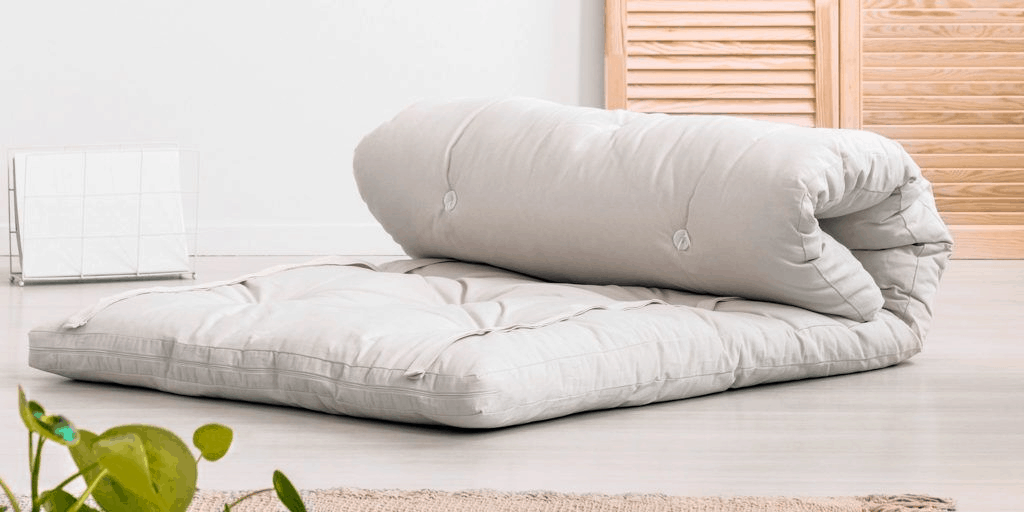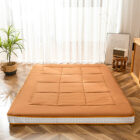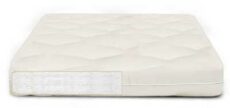If you don’t have a lot of free space or if you just need an extra sleeping area in a room, you should consider getting a Japanese futon mattress. Japanese futon mattresses are an excellent option if you need a space-saving piece of furniture that can be used both as a bed and a couch, depending on what you need. Use it as a couch during the day, and fold it down to use it as a bed at night. For extra comfort, use a thick, cushioned mat underneath them. But what are the benefits of traditional Japanese futon mattresses?
Some of the main benefits of traditional Japanese futon mattresses vs. mattresses are that they are thin and foldable. This means that they can be stored when not in use, which can save lots of space. You can use a Japanese futon mattress for both sleeping and sitting, depending on what type of surface you need. They are less expensive than other futon mattresses, and they are relatively easy to clean and take care of.
3 great comfortable futon we recommend
Traditional Japanese futons, or “shikibutons,” are a little different than typical futons. However, these differences in design make them a very versatile product. Traditional Japanese futon mattresses are slim, have a rectangular design, and have foldable cushions which are typically filled with cotton. These futon mattresses provide users with cushioned support and comfort. They are usually three inches thick, though some are four inches thick.
In Japan, people put these futons on top of a straw mat (called a tatami), and they use a blanket and a slim-profile pillow when it’s time for bed. In the morning, they hang their futon in the sun to kill any bacteria and freshen it up.
Below, we’ll discuss some of the benefits and disadvantages of Japanese futon mattresses.
Benefits and Disadvantages of Japanese Futon Mattresses
Benefits of Japanese Futon Mattresses
- Japanese futon mattresses are very beneficial for your back. For more information about how bed types can influence sleep and back pain symptoms, see this study.
- They can free up a lot of space in your room.
- They are extremely easy to clean and are cheaper than other beds.
- Their cotton construction is durable and breathable and allows for easy storage when not in use.
Here’s a highly rated Japanese futon mattress on Amazon.
Disadvantages of Japanese Futon Mattresses
- If you have difficulty getting up and down from the floor, these futons probably aren’t the best choice for you. For more information, see this study, which discusses the difficulty some people have getting up from a futon.
- Japanese futons are big. You’ll need a fair amount of closet space if you plan on putting it away during the day.
- You might find it tiring to put your bed in the closet during the day and lay it out at night. You can’t take a spontaneous nap unless you make an effort to pull out your bedding.
On the other hand, you don’t need to put Western futon mattresses like this one away every day. You might also find that traveling with a Japanese Futon Mattress may be beneficial. Make sure to also check out our 10 tips to make a hotel bed firmer and more comfortable for more information.
Japanese Futon Mattresses vs. Typical Western Futon Mattresses
The differences between a normal futon mattress and a Japanese futon mattress may be confusing at first, especially if you’ve never been to Japan and don’t know a lot about their culture.
When comparing Japanese futon mattresses vs. normal futon mattresses, the main differences between them are flexibility and thickness. Normal futon mattresses are generally more flexible than other mattresses, but Japanese futons are thinner and, therefore, much more flexible than western-style futons. Japanese futons and normal futons are made of different materials, and they are placed on different surfaces when sleeping.
Western-style futons (like this one) typically resemble low, wooden sofa beds, and they differ substantially from their Japanese counterparts. They often have the dimensions of a western mattress and are too thick to fold. They are also set up and stored on a slatted frame, which avoids having to regularly move them to air them out, especially in the dry indoor air of a centrally-heated house.
Basic Japanese futon mattresses are between two and four inches thick. In contrast, Western-style futon mattresses are six or more inches thick, and are designed to be folded after use, which isn’t possible with thicker Western-style futon mattresses (here’s an example of an 8-in western futon mattress). There are also no springs inside Japanese futon mattresses; they are typically stuffed with cotton, although there are luxury versions filled with silk. These futon mattresses are covered by a sheet, followed by a quilt in a quilt cover.
A Japanese futon is used in place of a Western-style bed. You can use an optional bottom material (called a tatami), which is a thin, cushy, quilt-like spread that goes between the mattress and floor (here’s one on Amazon). The futon mattress, placed on top, is long, narrow, and thin compared to a western-style futon mattress. Japanese futon mattresses do not require a bed frame and are much thinner than the mattress cushions found on normal futon sofas or beds.
Related Articles:
- The best futon mattresses (according to us)!
- How to raise the height of any mattress
Japanese Futon Mattresses for Reducing Back Pain?
Many of us think that if we have back pain, it’s better to sleep on something soft and cushioned. However, this really isn’t the case. A soft surface can cause the back to settle in an unnatural position that can make back pain even worse. For more information about how different mattress types can worsen or improve back pain and spinal alignment, see this study.
Japanese futon mattresses can reduce back pain because they are firm but still very supportive. They allow your back to form a natural alignment while providing a great level of comfort so that you will be able to sleep peacefully.
Many doctors and chiropractors are starting to recommend Japanese futon mattresses for people that have back pain problems and conditions like scoliosis. For more information about scoliosis and back pain, see this study. Additionally, if you are pregnant and considering a Japanese Futon Mattress, make sure to take a look at our guide to sleeping on a futon mattress while pregnant and our guide to choosing a mattress topper for back support.
Tips To Make a Japanese Futon Mattress Softer
To make a Japanese futon mattress softer, consider the material the futon is made from, place an air mattress on top of your futon, and add a featherbed or a mattress topper.
Follow these tips if you want to make a Japanese futon mattress softer:
Tip 1. Consider the mattress’ material when choosing which a Japanese futon mattress to buy
A comfortable futon mattress can make a huge difference when you want a good night’s sleep. Futon mattresses come in a variety of different thicknesses, with thicker mattresses being a lot more comfortable. However, you should also consider the material of the mattress. Foam mattresses are better than cotton ones at holding their shape over time. However, cotton shikibutons like this one are more traditional.
Tip 2. Consider placing an air mattress on top of your Japanese futon
Futon mattresses are often only a foot or less off the ground, and some people find it difficult to sit and lie down that low. To make your mattress more comfortable, consider placing an air mattress on top of your futon. This combination can provide a double dose of comfort and support, as well as adding extra height for people who need it. Look for an air mattress that fits your futon perfectly, and find a model that inflates and deflates automatically to make the whole process easier.
Tip 3. Add a featherbed or mattress topper
Consider adding a featherbed or a mattress topper to the futon mattress. Featherbeds and mattress toppers are types of bedding that you can put on top of your mattress to make it softer and more cushioned. Adding a featherbed or mattress topper is guaranteed to make your mattress softer. A simple memory foam mattress topper like this one should do the trick. For more ideas, take a look at our in-depth guide to choosing a mattress topper.
You might also enjoy this article on how to fix a mattress protector that makes you sweat or sleep hot on a futon.
Are Japanese Futon Mattresses Comfortable To Sit On?
Japanese futon mattresses are comfortable to sit on if you have a thick, high-quality futon mattress. It is important that the futon is firm, so you don’t sink into it. If you have a lower-quality futon mattress, it may not be comfortable to sit on.
Choosing the right type of futon for sitting is important. If you are going to use your futon primarily as a sofa for sitting, it is important that the mattress be of a certain thickness and designed with the right materials in order to be comfortable for you. This Japanese futon mattress has a 4-inch thickness and can be folded on itself for padding while you sit on it.
Most futon mattresses are made from cotton or a combination of both cotton and foam. You may want to keep in mind that cotton can get compressed over time, especially when all of the weight is concentrated in one spot. If you’re considering buying a futon mattress, take a look at our futon frame size guide for more options and sizes to fit your needs.
How To Take Care of a Japanese Futon Mattress vs. Typical Futon Mattress
One of the most important things to know when you get a Japanese futon mattress is how to properly take care of it. This will be different from how you would take care of a normal futon mattress.
To take care of a Japanese futon mattress, make sure to air it out regularly to prevent moisture and mold from building up. For normal futon mattresses, make sure to clean up any spills or stains as soon as they happen, and vacuum the mattress regularly.
The most important thing you can do to maintain your Japanese futon mattress is to dry it outside regularly. Airing out your futon should be done on a regular basis because people generally sweat at least one cup of water a night. You might think that this doesn’t make an impact on the mattress, but with moisture comes mold and “dani.” “Dani” is a Japanese word that refers to mites or ticks. Dani are tiny, almost invisible mites that live indoors, flourish in moist places, and sometimes even bite and drink human blood.
In addition to battling mold and dani, regularly airing out your futon also keeps it fresh and nice-smelling, and maintains the fluffy texture. While airing out your futon outside is ideal, sometimes it isn’t possible to do so. If that’s the case, you can dry your futon inside.
It will be more challenging to air out a typical futon mattress regularly due to its greater size and thickness. To take care of a typical futon mattress, vacuum it regularly and spot clean the futon if there are any stains or spills.
Make sure not to beat your Japanese or western-style futon. Although in Japan, it was traditionally believed that using a stick to beat a futon after it dried would get all the dust out, it’s actually not very helpful – it will actually spread allergens and damage the futon.
Don’t forget to air out your pillow, too, no matter what type of futon you have. There are pillow holders specifically made to hang pillows out in the sun on a clothesline. However, it is perfectly fine to put some newspaper in your yard or on your balcony and then lay your pillow on top. Let it dry for one hour in the sun and then flip it, letting the other side dry for an hour as well. Make sure to take a look at our step-by-step guide to cleaning your futon mattress for more tips and tricks.




